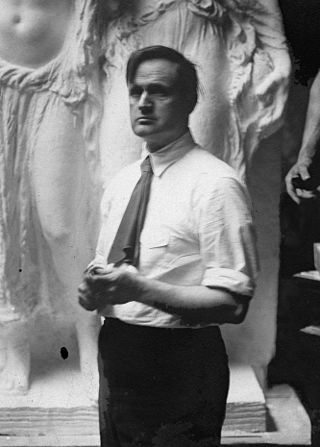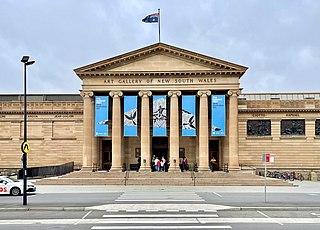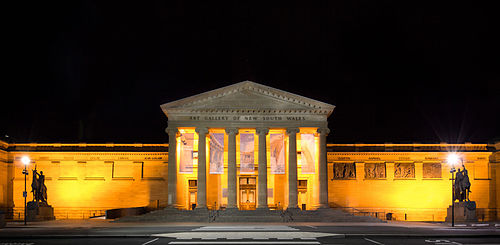
Edward Hodges Baily was a prolific English sculptor responsible for numerous public monuments, portrait busts, statues and exhibition pieces as well as works in silver. He carved friezes for both the Marble Arch and Buckingham Palace in London. His numerous statues of public figures include that of Horatio Nelson on top of Nelson's Column and Charles Grey, 2nd Earl Grey on Grey's Monument in Newcastle upon Tyne. Throughout his career Baily was responsible for creating a number of monuments and memorials for British churches and cathedrals, including several in St Paul's Cathedral.

Sir William Hamo Thornycroft was an English sculptor, responsible for some of London's best-known statues, including the statue of Oliver Cromwell outside the Palace of Westminster. He was a keen student of classical sculpture and was one of the youngest artists to be elected to the Royal Academy, in 1882, the same year the bronze cast of Teucer was purchased for the British nation under the auspices of the Chantrey Bequest.

James Earle Fraser was an American sculptor during the first half of the 20th century. His work is integral to many of Washington, D.C.'s most iconic structures.

The Art Gallery of New South Wales (AGNSW), founded as the New South Wales Academy of Art in 1872 and known as the National Art Gallery of New South Wales between 1883 and 1958, is located in The Domain, Sydney, Australia. It is the most important public gallery in Sydney and one of the largest in Australia.

Alfred Adrian Jones was an English sculptor and painter who specialized in depicting animals, particularly horses. Before becoming a full-time artist he was an army veterinary surgeon for twenty-three years. On retirement from the Army, Jones established himself as an artist with a studio in London. He became a regular exhibitor at the Royal Academy and in commercial galleries from 1884 onwards. His training as a veterinary surgeon gave him a deep knowledge of equine anatomy which he used in his work to great effect. He created the sculpture Peace descending on the Quadriga of War, on top of the Wellington Arch at Hyde Park Corner in London. Following both the Boer War and World War I, Jones created a number of notable war memorials including the Royal Marines Memorial and the Cavalry of the Empire Memorial, both in central London. Alongside the public monuments he created, Jones made equestrian and equine statuettes and portrait busts. Whilst well known as a sculptor, Jones was also an accomplished painter.

Sir Edgar Bertram Mackennal, usually known as Bertram Mackennal, was an Australian sculptor and medallist, most famous for designing the coinage and stamps bearing the likeness of George V. He signed his work "BM".

Thomas Thornycroft was an English sculptor and engineer.
Gilbert William Bayes was an English sculptor. His art works varied in scale from medals to large architectural clocks, monuments and equestrian statues and he was also a designer of some note, creating chess pieces, mirrors and cabinets.
Kaldor Public Art Projects is an Australian non-profit arts organisation established in 1969 by John Kaldor. The organisation collaborates with international artists to create site-specific art projects in public spaces in Australia.

Sydney March (1876–1968) was an English sculptor. His primary focus was portrait busts and other sculptures of British royalty and contemporary figures, as well as war memorials. The second-born of eight artists in his family, he and his siblings completed the National War Memorial of Canada after the death of their brother Vernon March in 1930, who had created the winning design. It is the site in Ottawa of annual Remembrance Day ceremonies.

Tatzu Nishi is a Japanese site specific installation artist. Nishi is known for his art interventions, which often transform historical monuments by surrounding a statue or a small element of a building with domestic space. In some cases the sculptures also operate as functioning hotels. Nishi has created and exhibited works under the pseudonyms Tatzu Oozu, Tatsurou Bashi, Taturo Atzu, and Amabouz Taturo.

The Arts of War and The Arts of Peace are bronze, fire-gilded statue groups on Lincoln Memorial Circle in West Potomac Park in Washington, D.C., in the United States. Commissioned in 1929 to complement the plaza constructed on the east side of the Lincoln Memorial as part of the Arlington Memorial Bridge approaches, their completion was delayed until 1939 for budgetary reasons. The models were placed into storage, and the statues not cast until 1950. They were erected in 1951, and repaired in 1974.

Physical Energy is a bronze equestrian statue by English artist George Frederic Watts. Watts was principally a painter, but also worked on sculptures from the 1870s. Physical Energy was first cast in 1902, two years before his death, and was intended to be Watts's memorial to "unknown worth". Watts said it was a symbol of "that restless physical impulse to seek the still unachieved in the domain of material things". The original plaster maquette is at the Watts Gallery, and there are four full-size bronze casts: one in London, one in Cape Town, one in Harare and one soon to be sited at Watts Gallery - Artists' Village in Compton, Surrey. Other smaller bronze casts were also made after Watts's death.

The statue of the Earl Kitchener is an outdoor bronze statue by John Tweed depicting Herbert Kitchener, 1st Earl Kitchener, installed in 1926 and located on the south side of Horse Guards Parade in London, United Kingdom. The sculpture stands on a Portland stone plinth. It contains the following inscription: KITCHENER/ 1850–1916/ ERECTED BY PARLIAMENT.

A 1926–27 statue of George Washington by Italian American artist Pompeo Coppini, sometimes called George Washington, was installed in northeast Portland, Oregon, United States. The bronze sculpture was the second of three statues of Washington by the artist, following a similar statue installed in Mexico City in 1912 and preceding another installed on the University of Texas at Austin campus in February 1955. The Portland statue was created to commemorate the 1926 sesquicentennial of the Declaration of Independence and dedicated in 1927. It was part of the City of Portland and Multnomah County Public Art Collection courtesy of the Regional Arts & Culture Council. In June 2020, it was toppled by protestors.

The Thames Ditton Foundry was a foundry in Thames Ditton, Surrey, which operated from 1874 to 1939 and which under various owners produced numerous major statues and monuments as one of the United Kingdom's leading firms of bronze founders.

Adela Dora Ohlfsen-Bagge, known professionally as Dora Ohlfsen, was an Australian sculptor and art medallist. Working mostly in Italy, her first prominent work was a bronze medallion, The Awakening of Australian Art (1907), which won an award at the 1908 Franco-British Exhibition in London and was purchased for the Petit Palais in Paris. Other notable works include the Anzac Medal (1916), created to raise funds for Australians and New Zealanders who fought in the Gallipoli campaign, and Sacrifice (1926), the war memorial in Formia, Italy.
Formia War Memorial is an Italian war memorial erected in 1926 to commemorate the dead of the First World War and earlier conflicts. It stands in the Piazza della Vittoria, in the centre of Formia, a town on the coast of the Province of Latina beside the Tyrrhenian Sea, about 150 km (93 mi) southeast of Rome and 100 km (62 mi) northwest of Naples



















